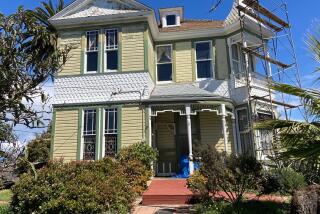Historic Queens Neighborhood Desperately Seeking Landmark Status
- Share via
NEW YORK — Hundred-foot trees, many 150 years old, form a canopy over the elegant homes--Tudor, Gothic and Victorian mansions among them. Sidewalks curve. There is much greenery, generous gardens in the summer and evergreens all year round.
A European village? A gracious New York suburb?
No, this is Flushing, in the New York City borough of Queens. More specifically, it is Waldheim--the oldest estate subdivision in a borough better known for plain apartment buildings and the kinds of houses Archie Bunker lived in. The name is German for “houses in the woods,” and it is a rare urban enclave.
But this mini-suburb’s character has been compromised by encroaching development over the last decade or so--and some homeowners, hoping to protect what’s left, are asking that the neighborhood be designated a historic district. So far they have been unsuccessful, despite the city’s changing attitude about Queens landmarks.
Individually designed and handcrafted during the late 19th and early 20th centuries, Waldheim’s houses were owned by wealthy New Yorkers--the founder of Buster Brown shoes, the owner of Hellmann’s mayonnaise, members of the Steinway piano family, prominent doctors.
In those days this was a Manhattan suburb, and the houses were expensive for the time, costing from $8,000 to $15,000. Over time, the city grew up around them and eventually encroached upon them.
In recent decades, Flushing’s economic growth and its new large immigrant population have spurred more demand for housing and community facilities.
Since the 1980s, a few houses in Waldheim have been demolished and replaced by modern-designed, two-family apartment buildings and churches.
That’s what sent concerned homeowners and preservationists to the New York City Landmarks Preservation Commission, asking it to designate Waldheim a historic district. This legal recognition, once approved by the City Council, restricts exterior changes to the houses and demolitions.
But the agency has rejected the application four times since 1987, most recently in September 1999.
The commission has repeatedly concluded that Waldheim does not meet its architectural and historical standards. “A historical district needs to be a cohesive sense of place. In Waldheim’s case, that sense of place has been compromised,” says Terri Rosen-Deutsch, the commission’s chief of staff. She adds that when commission staffers visited the neighborhood first in 1987, they already found intrusions.
Paul Graziano, a preservationist who has worked for Waldheim, doesn’t believe the community has to be pristine to be landmarked.
“Thirty-five percent of the Upper East Side’s buildings are nonconforming. Jackson Heights and Douglas Manor [both in Queens] have intrusions,” he says. About 85% of Waldheim’s original 110 buildings are intact.
He and other local preservationists believe the Landmarks Preservation Commission is slow to recognize landmarks outside Manhattan and Brooklyn. Those two boroughs have nearly 20,000 landmarked buildings between them; Queens has just 1,641.
Some Waldheim homeowners oppose landmark status, citing restrictions that come with it. A group of them went to Councilwoman Julia Harrison’s office to complain two years ago, said John Watts, the office’s chief of staff. Afterward, Harrison stopped supporting the effort. Sometimes a local councilperson’s support and cooperative neighbors greatly help a district become a landmark.
Queens’ working-class nature has always favored development over preservation, according to Stanley Cogan, the borough’s historian. In the late ‘70s and early ‘80s, Borough President Donald Manes blocked many designations, backing developers and homeowners wary of restrictions.
Since 1994, 11 individual landmarks and three districts in Queens have been recognized by New York City.
The Waldheim Neighborhood Assn. was formed two years ago. Since the most recent rejection by the landmarks commission, the group has turned to the National Register of Historic Places and its New York state equivalent for recognition.
This would offer no legal protection but might lead to financial incentives to preserve the homes and their history.
Waldheim’s treasures continue to disappear.
The most magnificent mansion, owned by Arthur Douglas Nash, a designer for Tiffany & Co., has been replaced by a two-family brick apartment building. Most of its windows, with Tiffany’s trademark stained-glass patterns, were sold just before demolition.
An Arts & Crafts bungalow, built in 1905 with dark wood siding and a partial facade of cobblestones, has been razed for another apartment building.
Other houses have been replaced by houses of worship, such as the Korean Buddhist temple, an off-white square stucco building with a soaring triangular roof, and a Japanese Buddhist temple, low-slung, multilevel, rectangular.
A nearby church’s blacktop parking lot is next door to Amal Martelli’s tall Colonial-design house.
“Living next to a parking lot is horrible, with its car fumes,” she complains. The lot dominates the view from her large dining room window.
Still, many people find Waldheim breathtaking. Strangers visit and take pictures, says Joan Damian, a longtime homeowner and president of the neighborhood group.
There is a tall, white Colonial with columns, nicknamed Tara by one admirer. An imposing three-story Tudor house evokes the Old World. A dark brown Colonial has whimsical green trim and shutters.
A three-story home, a blend of Victorian and Southern Colonial styles, was built in 1912 and owned by one of Waldheim’s developers. Its current owners, John and Maria Tsavalos, have preserved the house’s facade and restored original details, including its hardwood floors, pocket doors and wooden beams. “I prefer to see more homeowners, instead of churches, as neighbors,” says John Tsavalos, concerned with the area’s upkeep and appearance.
Preservationists such as Jim Driscoll of the Queens Historical Society say there are still enough houses to earn landmark recognition.
The citywide Historic Districts Council supported Waldheim’s latest application to the landmarks commission. Its former executive director, Vicki Weiner, thinks the estate has “architectural integrity and a lot of value” but is not yet appreciated by everyone.
Over 10 years, this community’s value has been appreciated by only a few preservationists and a fraction of its homeowners.
“It’s a shame to see the old homes go down,” Damian says.
More to Read
Sign up for Essential California
The most important California stories and recommendations in your inbox every morning.
You may occasionally receive promotional content from the Los Angeles Times.













